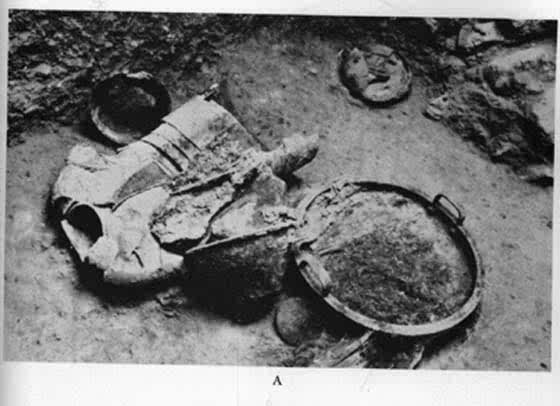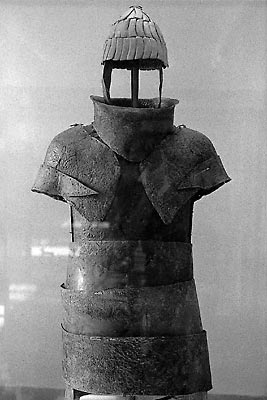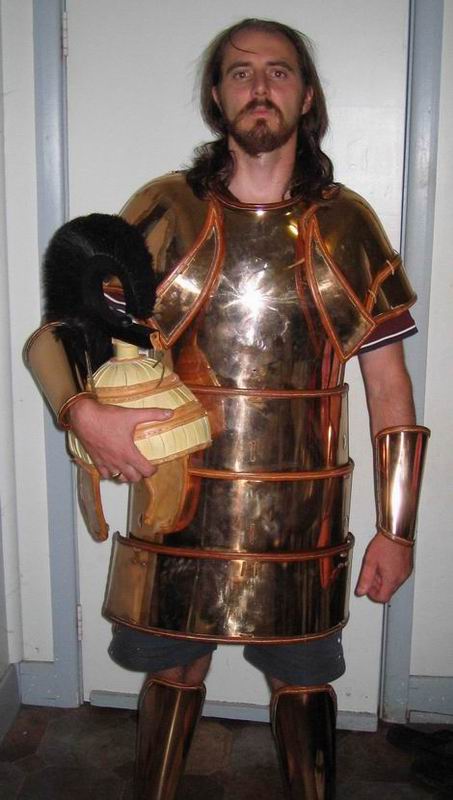Hi guys,
Nathan asked me to start a new thread about the Dendra Panoply.
Some background.
Dendra was the cemetery for the Mykenaian citadel at Midea. The armour found in a grave shaft here has been dated to around 1400 BC and is the only complete suit ever found, though pieces of similar armours have been found elsewhere. The report of the dig at Dendra can be found here.
Åstrom, Paul. "The Cuirass Tomb and Other Finds at Dendra, Part I: The Chamber Tombs." Studies in Mediterranean Archaeology, Vol. IV. Goteborg, Sweden, 1977. ISBN 91 85058 03 3
A lot of questions about my reconstruction are answered in this thread
http://z8.invisionfree.com/Bronze_Age_Center/...wtopic=347
but if you have any other questions I would be happy to answer them.
Dan
Some photos.
 Attachment: 23.47 KB
Attachment: 23.47 KB

Original photo of the armour in situ
 Attachment: 21.66 KB
Attachment: 21.66 KB

Original armour in the Archaeological Museum of Nauplion.

Original photo of the armour in situ

Original armour in the Archaeological Museum of Nauplion.
Andrews reconstruction.
 Attachment: 54.42 KB
Attachment: 54.42 KB

Here is Dan wearing Andrew's reconstruction a few days after it arrived.
 Attachment: 71.67 KB
Attachment: 71.67 KB
Here is Andrew wearing his reconstruction [ Download ]

Here is Dan wearing Andrew's reconstruction a few days after it arrived.
Here is Andrew wearing his reconstruction [ Download ]
Great photos. Do you have any comments about the panoply in terms of weight, balance, freedom of movement, etc.?
Yes! Pleas tell me too how mobile you can be in this armour?Because I've heard many dofferent opinions...Is it good for foot combat or maybe for chariot rider?(forgive me my ignorance-I have not much experience in arms before middle ages... :\ )
Dan, owning and wearing an accurate reconstruction of this armour I wonder if you could share your expirience with its mobility. The reason I ask is that in some of the reading i've done its been positied that this suit must have been for ceremony or the like as it couldn't have been very mobil and since you've actually worn it or rather a good recreation of it i'd be curious to hear what you think. I'm not as up on this period as I should be so i'm looking forward to yoru response.
Hi Dan!
Thanks for sharing those pictures. The in situ pictures are interesting. The Dendra panoply was in pretty good shape, wasn't it? I wish we could find more stuff in such good shape. Is that a shield next to the cuirass? If it is, would it be associated with the panoply, or would it be separate? Anything you can tell us about any other items found at the site would be greatly appreciated.
Thanks especially for sharing the large size pictures of you in your reproduction. It's easier to make out some of the subtle details.
I, too, would like to know about your mobility while wearing the panoply. I've heard it might have been more suited for a chariot driver. Your thoughts?
Thanks again!
Stay safe!
Thanks for sharing those pictures. The in situ pictures are interesting. The Dendra panoply was in pretty good shape, wasn't it? I wish we could find more stuff in such good shape. Is that a shield next to the cuirass? If it is, would it be associated with the panoply, or would it be separate? Anything you can tell us about any other items found at the site would be greatly appreciated.
Thanks especially for sharing the large size pictures of you in your reproduction. It's easier to make out some of the subtle details.
I, too, would like to know about your mobility while wearing the panoply. I've heard it might have been more suited for a chariot driver. Your thoughts?
Thanks again!
Stay safe!
Hello again!
Dan,
So, the original was trimmed in leather? Interesting; that's a detail that seems to be lacking in the books I have that mention the Dendra panoply. I think I can see a small line of holes along the edge of one of the shoulder plates of the panoply on display. It would seem to make logical sense; protect the plates from scratching perhaps.
Have you decided whether or not to line the plates with linen? I read on the thread you linked to that you had thought about it. I'm interested to learn what improvement this might have made, if you did line it in the end.
Thanks again.
Stay safe!
Dan,
So, the original was trimmed in leather? Interesting; that's a detail that seems to be lacking in the books I have that mention the Dendra panoply. I think I can see a small line of holes along the edge of one of the shoulder plates of the panoply on display. It would seem to make logical sense; protect the plates from scratching perhaps.
Have you decided whether or not to line the plates with linen? I read on the thread you linked to that you had thought about it. I'm interested to learn what improvement this might have made, if you did line it in the end.
Thanks again.
Stay safe!
I am astonished! One sees design elements of what would normaly be considered belonging to the 15th century suits, pre-dating by 2000 years! Certain pauldron elements havn't even changed. Compare with the Milanese "Churburg" harness. Just goes to help disprove the common misconception that old cultures were not advanced...
Regarding movement. The entire panoply including helmet, greaves and gorget weighs just over 25 kg. Even though it seems to fit me quite well, a lot of the weight is still carried on the shoulders. It is possible to run, lay down, jump up, etc. I even played cricket in it after Andrew said that he did it. It is hard to lift up one's arms above the head and it is fairly hard to throw a javelin but one can fire a bow while wearing it. It is definitely not too encumbering to wear if fighting on foot. However the gorget simply sits over the shoulders with no means of fastening it in place. It jumps around a lot if one is attempting to fight on foot. Personally I think that the armour was worn by a charioteer and I'm currently exploring the possibility that it was actually worn by the driver (the guy holding the reins) and not the passenger (the guy with the weapons).
Regarding the lining. I only considered adding a linen liner because that is how I think the original was constructed. I have no idea what effect it will have. It is a marvellous example of how useful experimental archaeology is. In this case we add a liner, simulate a combat situation, and then observe the results.
| Richard Fay wrote: |
| Thanks for sharing those pictures. The in situ pictures are interesting. The Dendra panoply was in pretty good shape, wasn't it? I wish we could find more stuff in such good shape. Is that a shield next to the cuirass? If it is, would it be associated with the panoply, or would it be separate? Anything you can tell us about any other items found at the site would be greatly appreciated. |
I don't have access to Astrom's book at the moment so I can't list the other items found withthe armour. I can't remember what the circular object in the photo was but IIRC it wasn't a shield. IMO this armour was specifically designed to be used by a warrior who cannot carry a shield - either an archer or a driver.
The large round item is a large basin, definitely not a shield (unfortunately!). We just found out recently that the original (at least in its current state) weighs about 15 kilograms, so it's even lighter than Dan's reproduction. Probably that's only due to very subtle differences in thickness.
Be aware that most old books classify ANY piece of ancient armor as "ceremonial", either because it's "much too thin and light" or "much too thick and heavy"--and sometimes they're talking about the same item! In reality, most of the finds are the perfect thickness and weight to be very strong and fully functional armor.
Thanks, Dan, always happy to see posts about your baby!
Khairete,
Matthew
Be aware that most old books classify ANY piece of ancient armor as "ceremonial", either because it's "much too thin and light" or "much too thick and heavy"--and sometimes they're talking about the same item! In reality, most of the finds are the perfect thickness and weight to be very strong and fully functional armor.
Thanks, Dan, always happy to see posts about your baby!
Khairete,
Matthew
Really fascinating Dan. Thank you very much for sharing.
Kind regards
Manouchehr
Kind regards
Manouchehr
That's great. Now, if the 25-pound repro isn't really all that constricting, I wonder if a 15-pound version would be better--or worse because the components get rattled and thrown around more easily?
Just a thought, regarding the panoply being intended for charriot drivers. One thing that makes me question this theory is the leg greaves. If the driver is standing in the charriot, wouldn't the lower legs be out of reach? These greaves make a lot more sense on foot, or on horseback.
Yep, that is annoying me also. My reasoning for making the driver the most heavily armoured is here.
http://z8.invisionfree.com/Bronze_Age_Center/...wtopic=433
http://z8.invisionfree.com/Bronze_Age_Center/...wtopic=433
| Dan Howard wrote: |
| However the gorget simply sits over the shoulders with no means of fastening it in place. It jumps around a lot if one is attempting to fight on foot.
|
Since I assume you did some very careful research on it before having it made, the reason there is no means of fastening the gorget is that there was no evidence of any form of attachments or even holes that would permit attachment.
I'm just wondering if some form of attachment could have existed that would leave no trace on the gorget ? A lining with attachments glued on or physically attached in a way that didn't need any holes.
Maybe a bulky leather or padded fabric collar on some sort of arming coat that the gorget would fit tightly on so as to not move around.
Any remote possibility that the Dendra panoply was intended to be used with some sort of unknown arming clothes ?
Like someone said before there are elements to this armour that are similar in looks to armour used 2000 years later and maybe other much later things like arming clothes would have been in use ?
The obvious answer is that we don't know and there is no evidence for such and I'm just bringing this up as possibilities and am curious if any of it makes sense to you. :D
By the way it's a great looking piece of armour. :cool:
Hello all!
Dan,
I've got a couple of ideas about that ring on the pauldron. I'm wondering if it might have something to do with some sort of attachment for the gorget, to hold it in place. Maybe some sort of cords or thonging were somehow attached to the gorget and tied onto the ring. Is it possible that some sort of attachment of this sort would have been lost over the centuries? Is the ring in a position where this might be the case? Also, is there definitely no trace of a ring on the opposite side?
My other idea about the ring is that they might not have anything to do with the function of the pauldron, but may have had some decorative purpose. Is it possible that some sort of horsehair streamer or other form of decorative element may have been attached to the ring? It might give a cool effect when driving the chariot, with a cloth or horsehair streamer flapping in the breeze behind you. I know it's just speculation, but it's an idea (and maybe a wild, far-out one at that).
As for the greaves, might they be more of a sort of status symbol? How protected were the legs of chariot drivers? Did the chariots of the time have solid sides or sides made of an open framework? If the greaves were unnecessary, perhaps they were included as a sign of wealth. I do believe that I read elsewhere that the Dendra panoply was possibly used by a chariot driver; it seems to make sense to me. The chariot is going to do the warrior who rides in it little good if the driver is taken out!
One other thing, the authors of Brassey's Book of Body Armour suggested that the plates of the cuirass were lined with leather. Is this likely, or is linen more likely? If you believe that it was lined with linen, why? Would it be a sort of light padding, or just plain cloth? What benefit would a linen lining give? Just wondering! :)
I know, not only do I read too much, but I write too much, too! ;) (And maybe even think too much and ask too many questions as well!)
Thanks again!
Stay safe!
| Dan Howard wrote: |
|
Shoulder pauldrons. Each consists of three plates. Can't see any discernable differences between these and the originals. The right one even has the small ring riveted near the top edge just like the original. Not sure what this ring is for - possibly to secure a weapon belt or quiver strap. |
Dan,
I've got a couple of ideas about that ring on the pauldron. I'm wondering if it might have something to do with some sort of attachment for the gorget, to hold it in place. Maybe some sort of cords or thonging were somehow attached to the gorget and tied onto the ring. Is it possible that some sort of attachment of this sort would have been lost over the centuries? Is the ring in a position where this might be the case? Also, is there definitely no trace of a ring on the opposite side?
My other idea about the ring is that they might not have anything to do with the function of the pauldron, but may have had some decorative purpose. Is it possible that some sort of horsehair streamer or other form of decorative element may have been attached to the ring? It might give a cool effect when driving the chariot, with a cloth or horsehair streamer flapping in the breeze behind you. I know it's just speculation, but it's an idea (and maybe a wild, far-out one at that).
As for the greaves, might they be more of a sort of status symbol? How protected were the legs of chariot drivers? Did the chariots of the time have solid sides or sides made of an open framework? If the greaves were unnecessary, perhaps they were included as a sign of wealth. I do believe that I read elsewhere that the Dendra panoply was possibly used by a chariot driver; it seems to make sense to me. The chariot is going to do the warrior who rides in it little good if the driver is taken out!
One other thing, the authors of Brassey's Book of Body Armour suggested that the plates of the cuirass were lined with leather. Is this likely, or is linen more likely? If you believe that it was lined with linen, why? Would it be a sort of light padding, or just plain cloth? What benefit would a linen lining give? Just wondering! :)
I know, not only do I read too much, but I write too much, too! ;) (And maybe even think too much and ask too many questions as well!)
Thanks again!
Stay safe!
Page 1 of 3
You cannot post new topics in this forumYou cannot reply to topics in this forum
You cannot edit your posts in this forum
You cannot delete your posts in this forum
You cannot vote in polls in this forum
You cannot attach files in this forum
You can download files in this forum
All contents © Copyright 2003-2006 myArmoury.com — All rights reserved
Discussion forums powered by phpBB © The phpBB Group
Switch to the Full-featured Version of the forum
Discussion forums powered by phpBB © The phpBB Group
Switch to the Full-featured Version of the forum